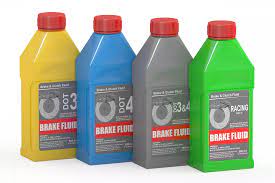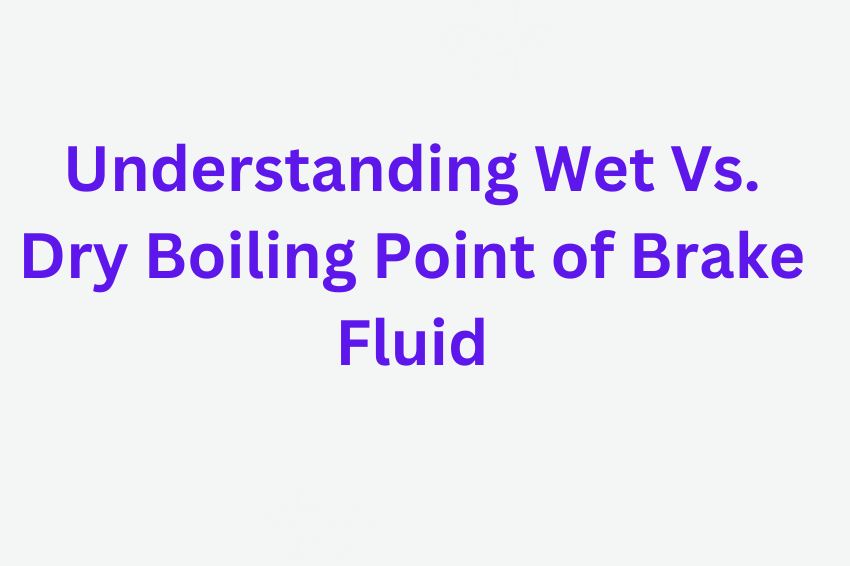Your brakes are important for safe driving.
They rely on a special fluid to transfer pressure and create the stopping power you need.
This fluid, brake fluid, can deteriorate over time, and understanding its boiling points is essential for maintaining optimal braking performance.
In this guide, you will learn:
- What dry and wet boiling points represent
- How moisture affects brake fluid
- Why the wet boiling point is more necessary for everyday driving
- How to choose the right brake fluid based on your vehicle’s needs
What Is The Difference Between Wet And Dry Boiling Points Of Brake Fluid?
- Dry Boiling Point (Fresh, Unopened Fluid): This signifies the temperature at which brand-new, unopened brake fluid boils.
The Department of Transportation (DOT) establishes a standardized test (Equilibrium Reflux Boiling Point or ERBP) to determine this value.
Imagine a sealed bottle of brake fluid. The dry boiling point reflects the temperature at which this fluid would boil under controlled conditions.
- Wet Boiling Point (Moisture-Absorbed Fluid): Unlike engine oil, brake fluid is hygroscopic, meaning it attracts and absorbs moisture from the air over time.
This absorbed water significantly lowers the boiling point.
The wet boiling point, again determined through a standardized DOT test, mirrors the temperature at which the fluid boils after reaching a specific moisture saturation level (typically around 3.7% by weight).
Think of the dry boiling point as the boiling temperature of water at sea level (sealed container).
The wet boiling point is similar to water at a higher altitude (open container absorbing moisture), lowering the boiling point.
However, If the brake fluid boils due to excessive heat and moisture, vapor bubbles can form within the braking system.
These compressible bubbles, unlike brake fluid, can lead to a spongy brake pedal and significantly reduce braking effectiveness, potentially causing accidents.
Different DOT classifications have varying dry and wet boiling points. The table below summarizes this for common DOT grades:
| DOT Grade | Typical Dry Boiling Point (°F) | Typical Wet Boiling Point (°F) |
| DOT 3 | 465 (240°C) | 284 (140°C) |
| DOT 4 | 480 (249°C) | 388 (198°C) |
| DOT 5.1 | 500 (260°C) | 392 (200°C) |
Selecting the appropriate DOT grade based on your vehicle’s specifications and driving habits is crucial.
Due to its hygroscopic nature, following the manufacturer’s recommended service intervals for flushing or changing the brake fluid is necessary.
This ensures the wet boiling point stays within safe limits for optimal braking system performance.
Refer to your owner’s manual for specific recommendations.
Why Is The Boiling Point Of Brake Fluid Important?
Imagine brake fluid like water in a pot.
When the brakes are applied, friction creates heat that transfers to the fluid.
If the fluid gets too hot, it boils and turns into vapor bubbles, just like boiling water.
These bubbles are compressible, unlike the fluid, which means they can’t transmit pressure effectively.
When you press the brake pedal, it pushes fluid to create pressure that squeezes the brakes.
But with vapor bubbles in the system, that pressure gets absorbed by the bubbles instead of stopping the car as intended.
This can lead to a spongy feeling in the pedal and a significant reduction in braking power, potentially causing accidents.
Everyday driving typically doesn’t push your brakes to their limits.
However, situations like mountain driving or towing heavy loads generate a lot of heat in the brakes.
Here’s where a higher boiling point becomes essential.
A higher boiling point ensures the fluid stays liquid under these demanding conditions, giving you the confident stopping power you need.
Another factor to consider is brake fluid’s tendency to absorb moisture from the air over time.
This moisture can further lower the boiling point, increasing the risk of vapor lock.
Regularly changing your brake fluid, as recommended by your car’s manual, helps maintain a safe boiling point for optimal braking performance.
How Does Water Affect The Boiling Point Of Brake Fluid?
Let’s assume brake fluid is a team of specialized workers designed to withstand the heat generated during braking.
Each worker molecule has a specific structure and function.
Now, view water molecules as having a completely different shape and purpose.
When water enters the brake fluid, it disrupts the well-organized team, weakening the overall structure and ability of the fluid to perform effectively.
Have you ever wondered why adding salt to water makes it boil at a higher temperature?
The salt disrupts the water molecules, making it harder for them to form vapor bubbles.
Similarly, water contamination disrupts the structure of brake fluid molecules, lowering its boiling point which is the temperature at which it transforms from a liquid to a vapor.
A lower boiling point due to water contamination means the brake fluid is more exposed to boiling under normal driving conditions.
Remember the team of workers?
With their structure weakened by water, they’re less equipped to handle the heat.
When the fluid boils, it creates vapor bubbles within the braking system.
Unlike the incompressible nature of the fluid, these vapor bubbles are compressible.
This means when you press the brake pedal, the pressure gets absorbed by the bubbles instead of effectively transferring it to the brakes.
This known as vapor lock, can lead to a spongy feeling in the brake pedal and a reduction in braking power, potentially causing accidents during emergencies.
While regular maintenance is essential, some warning signs might indicate water contamination in your brake fluid.
These can include a spongy feeling in the brake pedal or an increase in stopping distances.
If you experience any of these signs, don’t hesitate to consult a qualified mechanic.
Should I Use The Dry Or Wet Boiling Point When Selecting Brake Fluid?

Choosing the right brake fluid can be confusing, especially with terms like “dry boiling point” and “wet boiling point.”
Here’s what matters most for everyday driving:
Focus on the Wet Boiling Point.
Brake fluid naturally absorbs moisture from the air (it’s hygroscopic!).
This moisture lowers the wet boiling point, the temperature at which it boils under real-world conditions directly impacting braking performance.
A lower wet boiling point due to moisture can lead to vapor lock, reducing braking effectiveness and potentially causing accidents.
The dry boiling point, though impressive, reflects the maximum temperature of the brand-new fluid.
While it might be a consideration for scenarios like racing with extreme heat, for most drivers, the wet boiling point is the primary concern.
Now that you understand the importance of the wet boiling point, here’s what to do when choosing brake fluid:
Your car’s owner’s manual specifies the recommended Department of Transportation (DOT) grade for your brake fluid.
DOT grades consider both dry and wet boiling points.
Higher DOT grades typically have higher boiling points, but a mid-range grade might be sufficient for everyday driving.
Refer to your manual for specific recommendations.
While focusing on the wet boiling point is important, some signs might indicate water contamination: a spongy brake pedal or increased stopping distances.
If you experience these, consult a qualified mechanic.
DOT grades can influence replacement intervals.
Higher DOT grades might need more frequent changes due to faster moisture absorption.
Follow your owner’s manual for the recommended DOT grade and replacement schedule.
